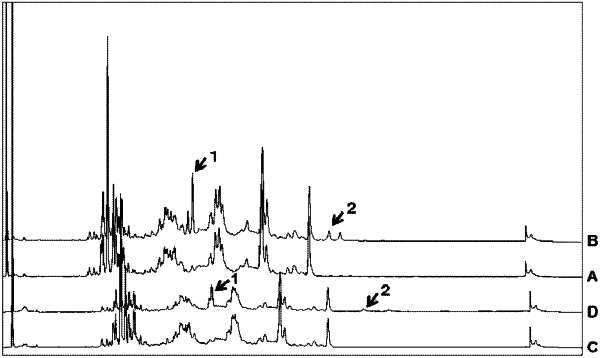| CPC B01J 20/283 (2013.01) [B01D 15/1871 (2013.01); B01D 15/305 (2013.01); B01D 15/363 (2013.01); B01J 20/285 (2013.01); B01J 20/286 (2013.01); B01J 20/3219 (2013.01); B01J 20/3248 (2013.01); B01J 41/05 (2017.01); B01J 41/07 (2017.01); B01J 41/14 (2013.01); B01J 41/20 (2013.01); G01N 30/06 (2013.01); G01N 30/34 (2013.01); G01N 30/46 (2013.01); G01N 30/461 (2013.01); G01N 30/74 (2013.01); G01N 30/88 (2013.01); C07K 16/00 (2013.01); G01N 2030/067 (2013.01); G01N 2030/8836 (2013.01)] | 7 Claims |

|
1. Method for separating an acidic sugar chain from a sample, the method comprising:
labeling the acidic sugar chain in the sample with an aminopyridine;
subjecting the sample comprising an aminopyridine-labeled acidic sugar chain to chromatography on a chromatography column, the chromatography column comprising a first column having an outlet, and a second column connected downstream of the outlet of the first column, wherein the first column comprises a carrier 1 which is hydrophobically modified silica having a group comprising at least one of a primary amine, a secondary amine and a tertiary amine, and the second column comprises a carrier 2 which is a resin having an amino group of the following formula III:
Y—NH(CH2CH2NH)nH, formula III
where Y represents a resin portion of the carrier 2, and n is an integer of 1 to 8;
continuously directing an effluent from the chromatography column to a flow path;
continuously measuring fluorescence intensity of the effluent flowing in the flow path; and
identifying a peak of fluorescence intensity corresponding to the acidic sugar chain in an obtained chromatogram,
wherein the subjecting of the sample to the chromatography comprises passing a first mobile phase through the chromatography column and thereafter passing a second mobile phase through the chromatography column, wherein the second mobile phase has hydrophobicity lower than hydrophobicity of the first mobile phase.
|